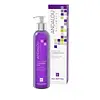What's inside
What's inside
 Key Ingredients
Key Ingredients

 Benefits
Benefits

 Concerns
Concerns

 Ingredients Side-by-side
Ingredients Side-by-side

Aloe Barbadensis Leaf Juice
Skin ConditioningWater
Skin ConditioningRosa Damascena Flower
Skin ConditioningCocamidopropyl Betaine
CleansingGlycerin
HumectantSorbitol
HumectantSodium Methyl 2-Sulfolaurate
CleansingDisodium 2-Sulfolaurate
CleansingPanthenol
Skin ConditioningSodium Lauroyl Methyl Isethionate
CleansingSucrose Cocoate
EmulsifyingRosa Canina Fruit Oil
EmollientPunica Granatum Seed Oil
EmollientAllantoin
Skin ConditioningSodium Hyaluronate
HumectantMagnolia Officinalis Bark Extract
AntimicrobialBoswellia Serrata Extract
Skin ConditioningCamellia Sinensis Leaf Extract
AntimicrobialHibiscus Sabdariffa Flower Extract
Skin ConditioningLactic Acid
BufferingTocopherol
AntioxidantSodium Benzoate
MaskingPotassium Sorbate
PreservativeEthylhexylglycerin
Skin ConditioningEthyl Vanillate
PerfumingPelargonium Graveolens Flower Oil
MaskingCitrus Aurantium Dulcis Peel Oil
MaskingAloe Barbadensis Leaf Juice, Water, Rosa Damascena Flower, Cocamidopropyl Betaine, Glycerin, Sorbitol, Sodium Methyl 2-Sulfolaurate, Disodium 2-Sulfolaurate, Panthenol, Sodium Lauroyl Methyl Isethionate, Sucrose Cocoate, Rosa Canina Fruit Oil, Punica Granatum Seed Oil, Allantoin, Sodium Hyaluronate, Magnolia Officinalis Bark Extract, Boswellia Serrata Extract, Camellia Sinensis Leaf Extract, Hibiscus Sabdariffa Flower Extract, Lactic Acid, Tocopherol, Sodium Benzoate, Potassium Sorbate, Ethylhexylglycerin, Ethyl Vanillate, Pelargonium Graveolens Flower Oil, Citrus Aurantium Dulcis Peel Oil
Aloe Barbadensis Leaf Juice
Skin ConditioningHelianthus Annuus Flower
Skin ConditioningGlycerin
HumectantCaprylic/Capric Triglyceride
MaskingPrunus Armeniaca Kernel Oil
MaskingPrunus Amygdalus Dulcis Protein
Skin ConditioningGlyceryl Laurate
EmollientGlyceryl Stearate
EmollientCetyl Alcohol
EmollientPrunus Amygdalus Dulcis Oil
Skin ConditioningResveratrol
AntioxidantUbiquinone
AntioxidantVitis Vinifera Seed
Skin ConditioningAllantoin
Skin ConditioningTocopherol
AntioxidantMangifera Indica Seed Oil
EmollientHibiscus Sabdariffa Callus Extract
AntioxidantBorago Officinalis Seed Oil
EmollientPhenethyl Alcohol
MaskingEthylhexylglycerin
Skin ConditioningAloe Barbadensis Leaf Juice, Helianthus Annuus Flower, Glycerin, Caprylic/Capric Triglyceride, Prunus Armeniaca Kernel Oil, Prunus Amygdalus Dulcis Protein, Glyceryl Laurate, Glyceryl Stearate, Cetyl Alcohol, Prunus Amygdalus Dulcis Oil, Resveratrol, Ubiquinone, Vitis Vinifera Seed, Allantoin, Tocopherol, Mangifera Indica Seed Oil, Hibiscus Sabdariffa Callus Extract, Borago Officinalis Seed Oil, Phenethyl Alcohol, Ethylhexylglycerin
 Reviews
Reviews

Ingredients Explained
These ingredients are found in both products.
Ingredients higher up in an ingredient list are typically present in a larger amount.
Allantoin is a soothing ingredient known for its protective and moisturizingg properties. Because of this, it is often added to products with strong active ingredients.
Studies show higher concentrations of this ingredient can promote wound healing.
Though it can be derived from the comfrey plant, allantoin is produced synthetically for cosmetic products to ensure purity.
Learn more about AllantoinAloe Barbadensis Leaf Juice comes from leaves of the aloe plant. Aloe Barbadensis Leaf Juice is best known for helping to soothe sunburns. It is also anti-inflammatory, moisturizing, antiseptic, and can help heal wounds.
Aloe is packed with good stuff including Vitamins A, C, and E. These vitamins are antioxidants, which help fight free-radicals and the damage they may cause. Free-radicals are molecules that may damage your skin cells, such as pollution.
Aloe Barbadensis Leaf Juice also contains sugars. These sugars come in the form of monosaccharides and polysaccharides, folic acid, and choline. These sugars are able to help bind moisture to skin.
It also contains minerals such as calcium, 12 anthraquinones, fatty acids, amino acids, and Vitamin B12.
Learn more about Aloe Barbadensis Leaf JuiceEthylhexylglycerin (we can't pronounce this either) is commonly used as a preservative and skin softener. It is derived from glyceryl.
You might see Ethylhexylglycerin often paired with other preservatives such as phenoxyethanol. Ethylhexylglycerin has been found to increase the effectiveness of these other preservatives.
Glycerin is already naturally found in your skin. It helps moisturize and protect your skin.
A study from 2016 found glycerin to be more effective as a humectant than AHAs and hyaluronic acid.
As a humectant, it helps the skin stay hydrated by pulling moisture to your skin. The low molecular weight of glycerin allows it to pull moisture into the deeper layers of your skin.
Hydrated skin improves your skin barrier; Your skin barrier helps protect against irritants and bacteria.
Glycerin has also been found to have antimicrobial and antiviral properties. Due to these properties, glycerin is often used in wound and burn treatments.
In cosmetics, glycerin is usually derived from plants such as soybean or palm. However, it can also be sourced from animals, such as tallow or animal fat.
This ingredient is organic, colorless, odorless, and non-toxic.
Glycerin is the name for this ingredient in American English. British English uses Glycerol/Glycerine.
Learn more about GlycerinTocopherol (also known as Vitamin E) is a common antioxidant used to help protect the skin from free-radicals and strengthen the skin barrier. It's also fat soluble - this means our skin is great at absorbing it.
Vitamin E also helps keep your natural skin lipids healthy. Your lipid skin barrier naturally consists of lipids, ceramides, and fatty acids. Vitamin E offers extra protection for your skin’s lipid barrier, keeping your skin healthy and nourished.
Another benefit is a bit of UV protection. Vitamin E helps reduce the damage caused by UVB rays. (It should not replace your sunscreen). Combining it with Vitamin C can decrease sunburned cells and hyperpigmentation after UV exposure.
You might have noticed Vitamin E + C often paired together. This is because it is great at stabilizing Vitamin C. Using the two together helps increase the effectiveness of both ingredients.
There are often claims that Vitamin E can reduce/prevent scarring, but these claims haven't been confirmed by scientific research.
Learn more about Tocopherol